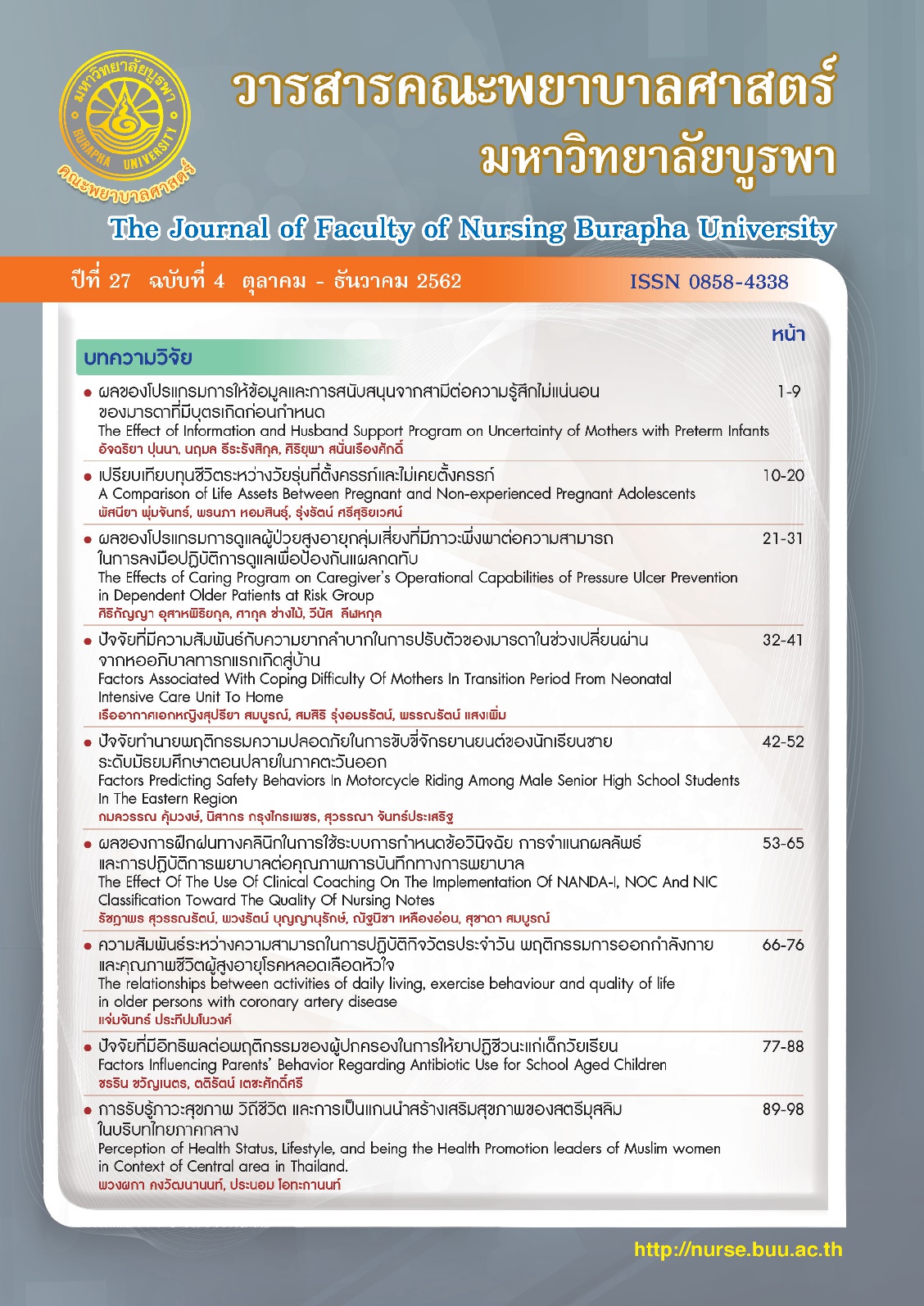ปัจจัยทำนายพฤติกรรมความปลอดภัยในการขับขี่จักรยานยนต์ ของนักเรียนชายระดับมัธยมศึกษาตอนปลายในภาคตะวันออก
คำสำคัญ:
พฤติกรรมความปลอดภัย, การขับขี่จักรยานยนต์, มัธยมศึกษาตอนปลาย, ภาคตะวันออกบทคัดย่อ
บทคัดย่อ
ประเทศไทยมีอัตราการเสียชีวิตจากการขับขี่รถจักรยานยนต์เป็นอันดับหนึ่งของโลกโดยเฉพาะกลุ่มวัยรุ่นชาย อายุ 15-19 ปี มีอัตราสียชีวิตเป็นอันดับหนึ่งของประเทศ การวิจัยนี้มีวัตถุประสงค์ เพื่อศึกษาปัจจัยทำนายพฤติกรรมความปลอดภัยในการขับขี่จักรยานยนต์ของนักเรียนชายระดับมัธยมศึกษาตอนปลายในภาคตะวันออก กลุ่มตัวอย่าง คือนักเรียนชายระดับมัธยมศึกษาตอนปลาย จำนวน 139 ราย ใช้วิธีสุ่มแบบหลายขั้นตอน เครื่องมือวิจัยเป็นแบบสอบถามแบ่งเป็น 5 ส่วน คือ 1) ข้อมูลส่วนบุคคล 2) การรับรู้ของบุคคล ประกอบด้วย การรับรู้โอกาสเสี่ยงของการเกิดอุบัติเหตุ การรับรู้ความรุนแรงของการเกิดอุบัติเหตุ การรับรู้ประโยชน์ของการขับขี่จักรยานยนต์ปลอดภัย การรับรู้อุปสรรคของการขับขี่จักรยานยนต์ปลอดภัย ค่าความเชื่อมั่นเท่ากับ .75 .80 .73 .64 ตามลำดับ 3) ประสบการณ์การขับขี่จักรยานยนต์ ประกอบด้วย ประสบการณ์การเกิดอุบัติเหตุ ประสบการณ์ทำผิดกฎจราจร 4) ปัจจัยด้านสิ่งแวดล้อมและสิ่งชักนำสู่การปฏิบัติ ประกอบด้วย นโยบายโรงเรียนด้านการขับขี่จักรยานยนต์ปลอดภัย สภาพวินัยจราจรบนถนน อิทธิพลของครอบครัว อิทธิพลของเพื่อน ค่าความเชื่อมั่นเท่ากับ .90 .80 .87 .87 ตามลำดับ และ 5) พฤติกรรมความปลอดภัยในการขับขี่จักรยานยนต์ ค่าความเชื่อมั่นเท่ากับ .75 วิเคราะห์ข้อมูลโดยใช้ สถิติเชิงพรรณนา และสถิติถดถอยพหุคูณ
ผลการวิจัยพบว่า การรับรู้ประโยชน์ของการขับขี่จักรยานยนต์ปลอดภัย อิทธิพลของครอบครัว และอิทธิพลของเพื่อน เป็นปัจจัยร่วมทำนายพฤติกรรมความปลอดภัยในการขับขี่จักรยานยนต์ได้ ร้อยละ 32.8 (R2.= .328, F = 8.52, p < .01) พยาบาลชุมชนจึงควรเสริมสร้างการรับรู้ประโยชน์ของการขับขี่จักรยานยนต์ปลอดภัย สร้างกลุ่มพลังเพื่อนดี และให้ความรู้ความเข้าใจกับครอบครัวให้ร่วมกระตุ้นเตือนนักเรียนชายมีพฤติกรรมขับขี่จักรยานยนต์ปลอดภัย
เอกสารอ้างอิง
Becker, M.H. (1974). The health belief model and preventive health behavior. Health Education Monographs. 2, (a), 354-385.
Biggins, O. (2013). Factors on drunk driving behavior and media exposure of motorcyclist in Bangkok metropolitan. Suddhiparitad, 27(82), 41-57. [In Thai]
Bureau of Non Communicable Disease. (2016). Decade of action for road safety. Nonthaburi: Bureau of Non Communicable Disease. [In Thai]
Bureau of Non Communicable Disease. (2016). Half the decade of road safety. Nonthaburi: Bureau of communicable disease. [In Thai]
Chonsalasin, D., Siridhara, S., Ratanavaraha, V., Jomnonkwoa, S., & Watthanaklang, D. (2017). A study of factors affecting Intention of helmet use: an application of the theory of health belief model. technical education. Journal King Mongkut’s University of Technology North Bangkok. 8(1), 26-35. [In Thai]
Griffin, M.A., and Neal, A. (2000). Perception of safety at work: a framework for linking safety climate to safety performance, knowledge, and motivation. Journal of occupational health psychology, 5(3), 347-358.
Hayeema S., Maka M., & Jeknu, R. (2009). Attitudes of student at Narathiwat Technical College and Princess of Narathiwat University about the policy of safe driving by turning on head light and wearing safety helmet. Princess of Narathiwat University Journal.1(3), 118-129. [In Thai]
Iamtrakul P., Simcharean P., & Jantaworn P., (2012). Participation of local communities in road safety through participation research approach (PAR): A case study of Thaklong municipality. Journal of Architectural planning research and studies.7(2), 59-71. [In Thai]
Jantarasukkho P., (2013). Factors relate to motorcyclist traffic violation. Academic service journal Prince of Songkhla University, 24(1), 110-120. [In Thai]
Khampukka, P., Yamram U., & Chomchuen, S. (2018). Traffic laws violation behaviors of motorcyclist in student of Uborajathanee university. Journal of management science, Ubonrajathanee University, 1(2), 50-75. [In Thai]
Khongtong, P., & Sukhon, S. (2013). Behaviors of riding motorcycles and participating and solving accident from riding motorcycle: case study at Tamirum subdistric, Muang district Phatthalung province. Journal of Srinakharinwirot Research and Development, 5(9), 116-130. [In Thai]
Office of transport and traffic policy and planning ministry of transport. (2013). Road accident analysis report of 2012. Retrieved February 10, 2018 from http://trsl.thairoads.org/FileUpLoad/1230/131208001230.pdf. [In Thai]
Pavayon, Y. (2014). The predictive factors of occupational injury protection behaviors among pile construction workers. Nursing journal, 42(4), 48-57. [In Thai]
Pholchai B., (2014). Perception of benefit, attitude and behavior to using helmet of nursing student, Nakhon Phanom university, Journal of Humanities and Social Science, Srinakharinwirot Research and Development, 6(11), 78-88. [In Thai]
Ratanavaraha V., (2009). Factors Affecting Motorcycle Helmet Use: Using Structural Equation Modeling (SEM) For The Thoery Of The Health Belief Model In Urban And Rural Area. Faculty of Engineering, Suranaree University of Technology.
[In Thai]
Sornpisol, B., Keawmungkun, J., Imsanpangk, S., Watthanaporn, K, Nasep, S., & Unlomlert, W. (2008). Thailand alcohol situation’2008. Bangkok: Center for alcohol studies.
Strategy and planning division ministry of public health. (2017). Important statistics 2016. Bangkok: Ministry of Public Health. [In Thai]
Su-angka, K. (2016). A study of young driver behavior that affect the risk of accidents from the motorcycle. Suranaree University of Technology, Nakhon ratchasima.
[In Thai]
Tabachnick, B.G., & Fidel, L.S. (1996). Using multivariate statistics. New York: Harper and row.
Tangkamonsri, B. (2016). Causal factors affecting safety behavior in driving among high school students in students in the northern region: multiple group analysis. Doctor of Philosophy, Research program educational measurement and statistics, Faculty of Education, Burapha University. [In Thai]
Upathump N. (2004). Perceived benefits, perceived barriers, perceived self-efficacy, and motorcycling safety behaviors of persons with and without experience of motorcycle accident. Master of nursing thesis, Adult nursing program, Graduate school, Prince of Songkhla university. [In Thai]
Vannabutr A., Tonmat J., Kraiwan V., Bonruangsri P., Kabae M., & Mameesuk V., (2008). Factor related to helmet wear behaviors of Chandrakasem Rajabhat University student. Bangkok: Chandrakasem University.
Vollakitkasemskul, S. (2011). Research methodology in behavioral sciences and social sciences. Bangkok: Aksonsin Printing House. [In Thai]
World Health Organization. (2018). Global status report on road safety 2018. Retrieved from https://www.who.int/violence_injury_prevention/ road_safety_status/2018/.





